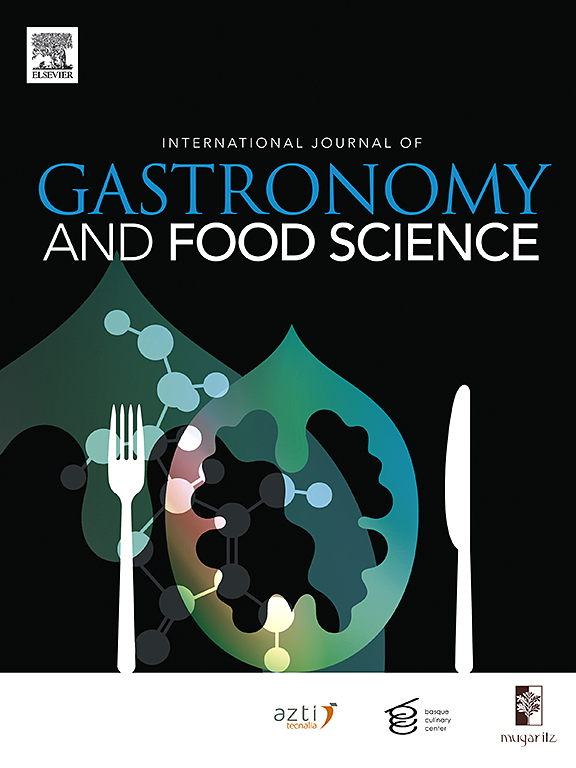‘Meating’ consumer expectations: More work required to improve acceptability of plant-based meat alternative products
IF 3.2
2区 农林科学
Q2 FOOD SCIENCE & TECHNOLOGY
International Journal of Gastronomy and Food Science
Pub Date : 2025-01-08
DOI:10.1016/j.ijgfs.2025.101102
引用次数: 0
Abstract
Plant-based meat alternatives (PBMA) offer a steppingstone towards healthier, more sustainable food systems. However, product acceptability is pivotal to successful consumer adoption and PBMAs must deliver a positive sensory experience. This study reports consumer acceptability and sensorial characterisation of five commercially available PBMA categories versus meat-based equivalents, stratified by exposure to product information (closed/open condition) and participants familiarity with PBMAs (habitual/habitual non-consumer). Naïve assessors were recruited to participate in sensory evaluation of plant-based burgers (n = 96), meatballs (n = 53), breaded ‘chicken’ (n = 62), plain ‘chicken’ (n = 47), and sausages (n = 23) versus meat-based equivalents. Acceptability was measured on a nine-point hedonic scale and sensorial characterisation was determined via check-all-that-apply questioning. In all cases but one, PBMAs were significantly less acceptable versus meat-based equivalents (p < .05). Overall burger acceptability was significantly higher in the closed versus open label condition (p = .046) and in habitual versus habitual non-consumers (p = .047). Condition and familiarity did not influence other PBMA categories. PBMA products were more frequently associated with off-flavours alongside a dry appearance and texture. Alternately, meat-based products were associated with meaty and umami flavours and a juicy texture. This study generates preliminary findings which indicate the need for evidence-based product development to improve PBMA acceptability, accelerate consumer adoption, and promote individual and planetary health.
“肉类”消费者的期望:需要做更多的工作来提高植物性肉类替代品的可接受性
植物性肉类替代品(PBMA)为实现更健康、更可持续的粮食系统提供了跳板。然而,产品的可接受性是成功的消费者采用的关键,pbma必须提供积极的感官体验。本研究报告了消费者对五种市售PBMA类别与基于肉类的等同物的可接受性和感官特征,根据产品信息(封闭/开放条件)和参与者对PBMA的熟悉程度(习惯性/习惯性非消费者)进行分层。Naïve评估人员被招募来参与对植物汉堡(n = 96)、肉丸(n = 53)、面包屑“鸡肉”(n = 62)、普通“鸡肉”(n = 47)和香肠(n = 23)与肉类同类产品的感官评估。可接受性是用九分制的快乐量表来衡量的,感官特征是通过检查所有适用的问题来确定的。除了一种情况外,在所有情况下,与基于肉类的等同物相比,pbma的可接受度明显较低(p <;. 05)。总体而言,汉堡的可接受性在封闭标签条件下明显高于开放标签条件(p = 0.046),在习惯性消费者条件下明显高于习惯性非消费者条件下(p = 0.047)。条件和熟悉程度对其他PBMA类别没有影响。PBMA产品通常与异味以及干燥的外观和质地有关。另外,以肉类为基础的产品与肉味、鲜味和多汁的口感有关。这项研究产生了初步的发现,表明需要以证据为基础的产品开发,以提高PBMA的可接受性,加速消费者的采用,促进个人和地球的健康。
本文章由计算机程序翻译,如有差异,请以英文原文为准。
求助全文
约1分钟内获得全文
求助全文
来源期刊

International Journal of Gastronomy and Food Science
Social Sciences-Cultural Studies
CiteScore
5.30
自引率
10.50%
发文量
170
审稿时长
45 days
期刊介绍:
International Journal of Gastronomy and Food Science is a peer-reviewed journal that explicitly focuses on the interface of food science and gastronomy. Articles focusing only on food science will not be considered. This journal equally encourages both scientists and chefs to publish original scientific papers, review articles and original culinary works. We seek articles with clear evidence of this interaction. From a scientific perspective, this publication aims to become the home for research from the whole community of food science and gastronomy.
IJGFS explores all aspects related to the growing field of the interaction of gastronomy and food science, in areas such as food chemistry, food technology and culinary techniques, food microbiology, genetics, sensory science, neuroscience, psychology, culinary concepts, culinary trends, and gastronomic experience (all the elements that contribute to the appreciation and enjoyment of the meal. Also relevant is research on science-based educational programs in gastronomy, anthropology, gastronomic history and food sociology. All these areas of knowledge are crucial to gastronomy, as they contribute to a better understanding of this broad term and its practical implications for science and society.
 求助内容:
求助内容: 应助结果提醒方式:
应助结果提醒方式:


